
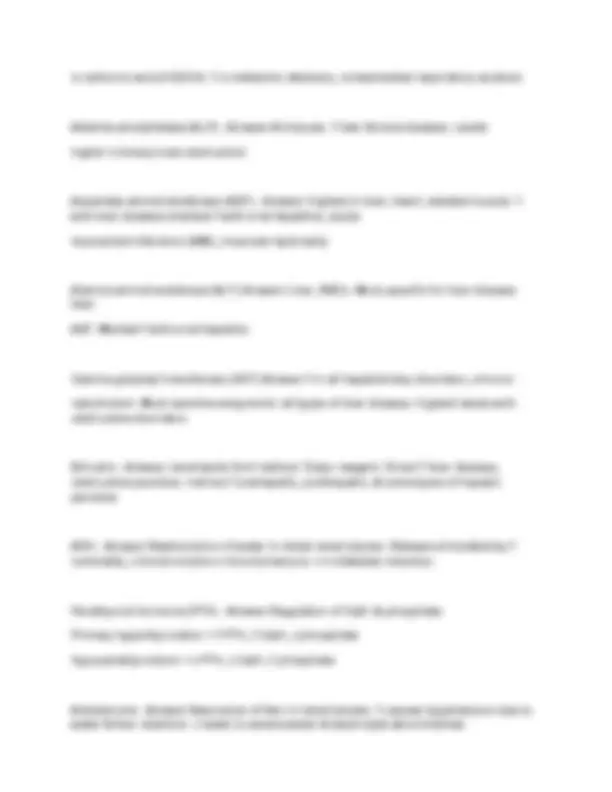
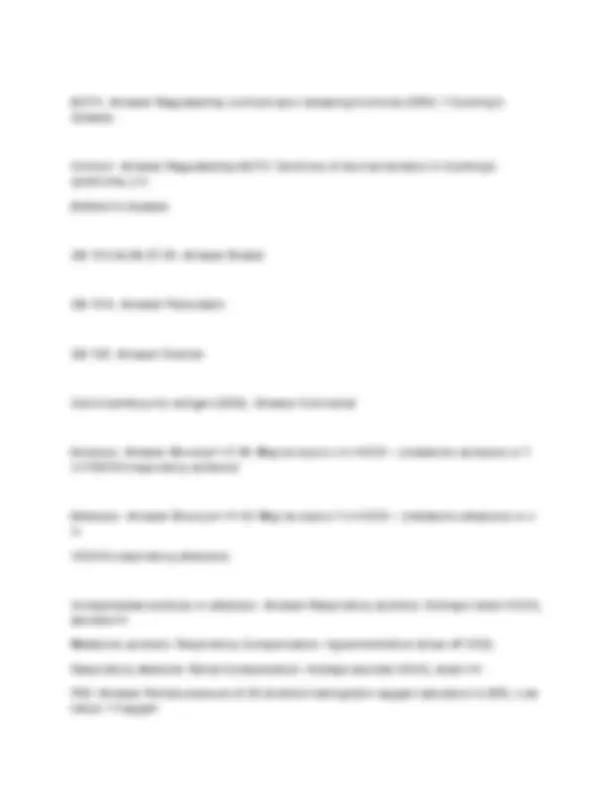
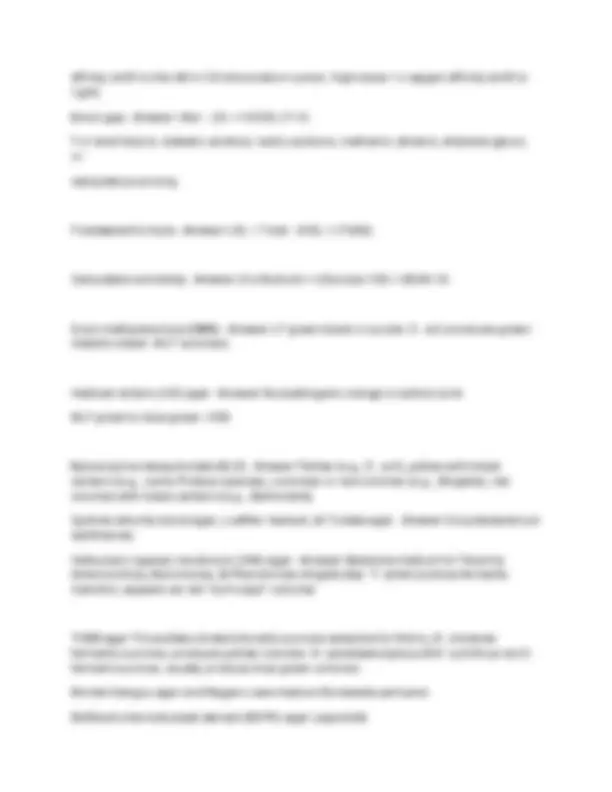
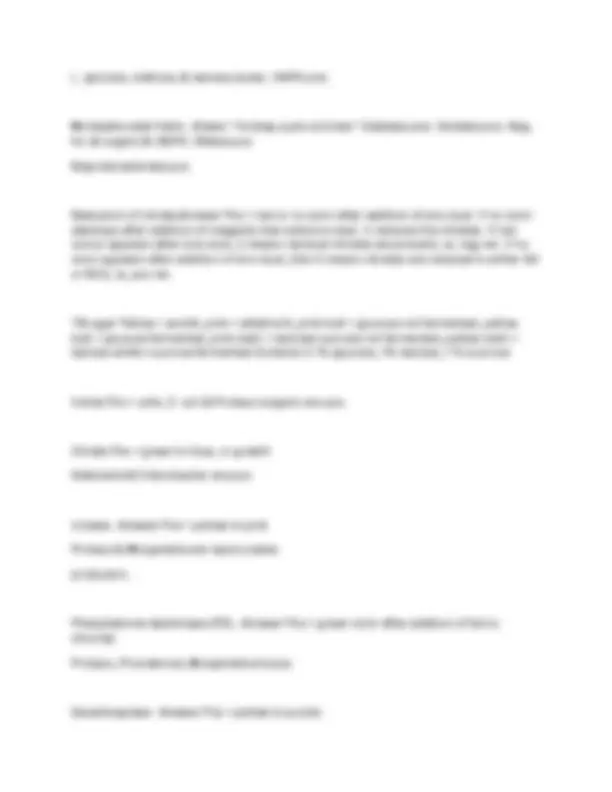
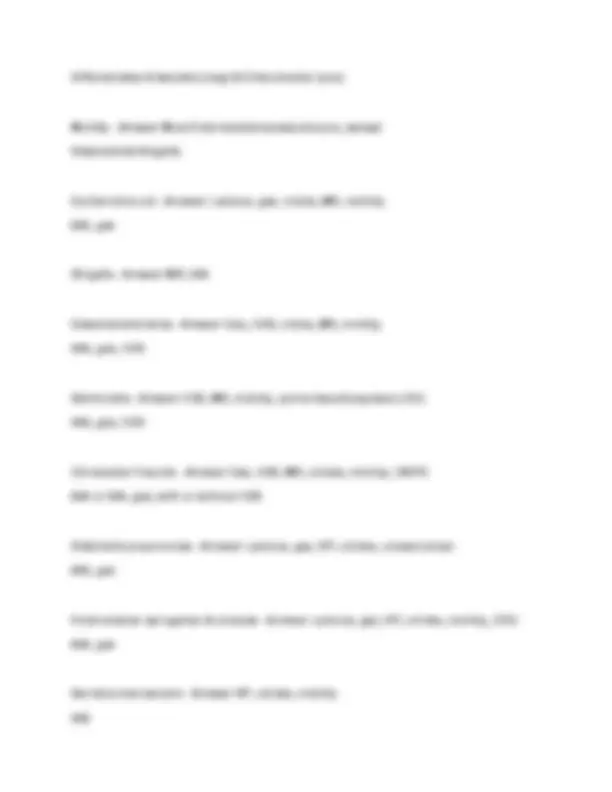
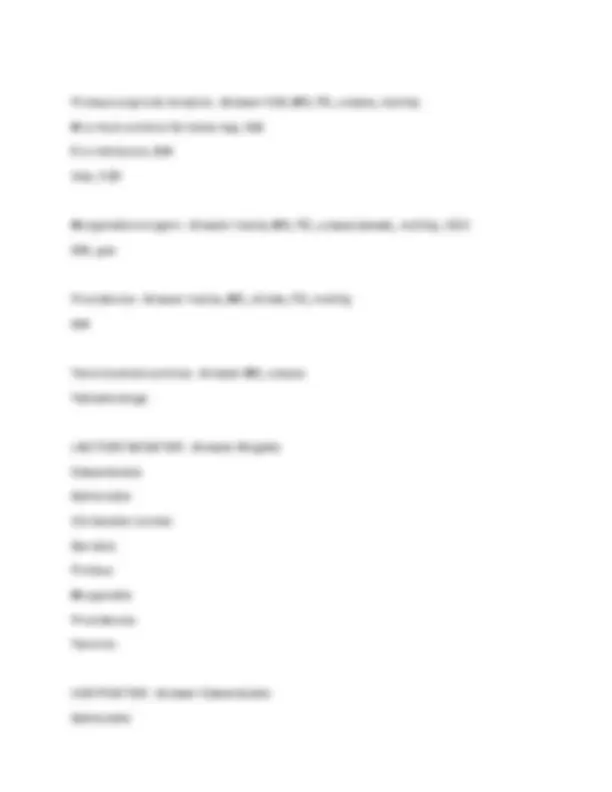
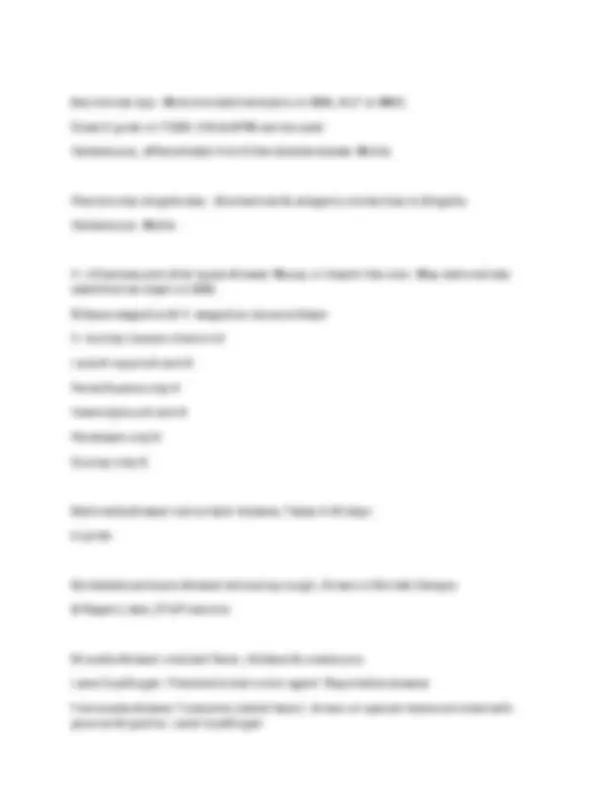
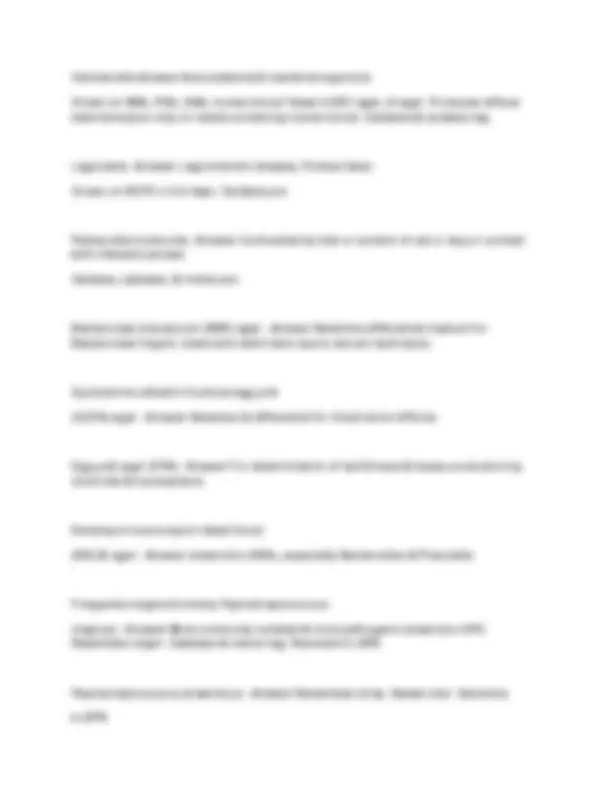
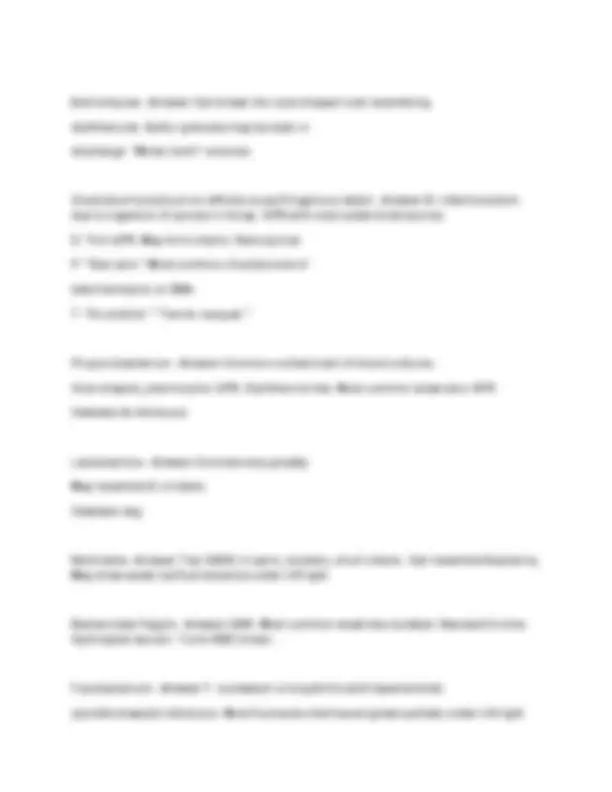


Study with the several resources on Docsity

Earn points by helping other students or get them with a premium plan


Prepare for your exams
Study with the several resources on Docsity

Earn points to download
Earn points by helping other students or get them with a premium plan
Community
Ask the community for help and clear up your study doubts
Discover the best universities in your country according to Docsity users
Free resources
Download our free guides on studying techniques, anxiety management strategies, and thesis advice from Docsity tutors
A compilation of multiple-choice questions and answers relevant to the mls ascp (medical laboratory science american society for clinical pathology) exam. It covers a wide range of topics in clinical laboratory science, including clinical chemistry, microbiology, and serology. The questions address key concepts, methodologies, and diagnostic criteria essential for medical laboratory professionals. This resource is designed to aid in exam preparation and reinforce understanding of core principles in laboratory medicine. It includes topics such as protein analysis, enzyme function, acid-base balance, tumor markers, and microbial identification techniques. The document serves as a valuable tool for students and professionals seeking to enhance their knowledge and skills in the field.
Typology: Exams
1 / 16

This page cannot be seen from the preview
Don't miss anything!










Total protein - Answer Biuret method. ↑ dehydration, chronic inflammation, multiple myeloma ↓ nephrotic syndrome, malabsorption, overhydration, hepatic insufficiency, malnutrition, agammaglobulinemia <4.5 g/dL associated with peripheral edema Albumin same except decreases with inflammation.
Phenylketonuria - Answer Mental retardation. Urine has "mousy" odor. All newborns are screened
Alkaptonuria - Answer Diapers stain black due to homogentisic acid in urine.
Maple syrup urine disease (MSUD) - Answer Enzyme deficiency leading to buildup of leucine, isoleucine, valine.
Homocystinuria - Answer Deficiency in enzyme required for metabolism of methionine. Methionine & homocysteine accumulate in plasma & urine.
Fluorometry - Answer Atoms absorb light of specific wavelength & emit light of longer wavelength (lower energy). Detector at 90º to light source Used to measure drugs, hormones.
Chemiluminescence - Answer Chemical rxn that produces light. Used for immunoassays.
Turbidimetry-Answer Measures reduction in light transmission by particles in suspension. Used to measure proteins in urine & CSF.
Nephelometry-Answer Similar to turbidity, but light is measured at angle from light source. Used to measure ag-ab rxn.
Serum Protein Electrophoresis-Answer Acute inflammation↑ alpha-1 & alpha- Chronic infection↑ alpha-1, alpha-2, & gamma Cirrhosis Polyclonal ↑(all fractions) in gamma w/ beta-gamma bridging Monoclonal gammopathy Sharp ↑ in 1 immunoglobulin ("M spike"). ↓ in other fractions Polyclonal gammopathy Diffuse ↑ in gamma Hypogammaglobulinemia ↓ gamma Nephrotic syndrome ↓ albumin, ↑ alpha- Alpha-1-antitrypsin deficiency ↓ alpha- Hemolyzed specimen ↑ beta or unusual band between alpha-2 & beta Plasma Extra band (fibrinogen) between beta & gamma
Creatinine - Answer ↑ kidney disease Jaffe's reaction (alkaline picrate)
Ammonia - Answer ↑ liver disease, hepatic coma, renal failure, Reye's syndrome
Sodium - Answer Regulated by aldosterone
Chloride - Answer Passively follows Na+. Sweat chloride test for Dx of cystic fibrosis.
CO2, total - Answer >90% is bicarbonate (HCO3-); remainder
ACTH - Answer Regulated by corticotropin-releasing hormone (CRH). ↑ Cushing's disease.
Cortisol - Answer Regulated by ACTH. ↑and loss of diurnal variation in Cushing's syndrome, ↓ in Addison's disease.
CA 15-3 & CA 27.29 - Answer Breast
CA 19-9 - Answer Pancreatic
CA 125 - Answer Ovarian
Carcinoembryonic antigen (CEA) - Answer Colorectal
Acidosis - Answer Blood pH <7.38. May be due to ↓ in HCO3 − (metabolic acidosis) or ↑ in H2CO3 (respiratory acidosis)
Alkalosis - Answer Blood pH >7.42. May be due to ↑ in HCO3 − (metabolic alkalosis) or ↓ in H2CO3 (respiratory alkalosis)
Compensated acidosis or alkalosis - Answer Respiratory acidosis: Kidneys retain HCO3, excrete H+ Metabolic acidosis: Respiratory Compensation- Hyperventilation (blow off CO2) Respiratory alkalosis: Renal Compensation- Kidneys excrete HCO3, retain H+ P50 - Answer Partial pressure of O2 at which hemoglobin oxygen saturation is 50%. Low value = ↑ oxygen
affinity (shift to the left in O2 dissociation curve). High value = ↓ oxygen affinity (shift to right) Anion gap - Answer -Na+ - (Cl- + HCO3-) 7- ↑ in renal failure; diabetic acidosis; lactic acidosis; methanol, ethanol, ethylene glycol, or salicylate poisoning
Friedewald formula - Answer LDL = Total - (HDL + (TG/5))
Calculated osmolality - Answer (2 x Sodium) + (Glucose / 20) + (BUN / 3)
Eosin methylene blue (EMB) - Answer LF green-black or purple. E. coli produces green metallic sheen. NLF colorless.
Hektoen enteric (HE) agar - Answer Nonpathogens orange to salmon pink. NLF green to blue-green. H2S
Xylose lysine deoxycholate (XLD) - Answer Yellow (e.g., E. coli), yellow with black centers (e.g., some Proteus species), colorless or red colonies (e.g., Shigella), red colonies with black centers (e.g., Salmonella). Cystine-tellurite blood agar, Loeffler medium, & Tindale agar - Answer Corynebacterium diphtheriae Cefsulodin-irgasan-novobiocin (CIN) agar - Answer Selective medium for Yersinia enterocolitica, Aeromonas, & Plesiomonas shigelloides. Y. enterocolitica ferments mannitol, appears as red "bull's-eye" colonies
TCBS agar Thiosulfate citrate bile salts sucrose selective for Vibrio, V. cholerae ferments sucrose, produces yellow colonies. V. parahaemolyticus & V. vulnificus don't ferment sucrose; usually produce blue-green colonies. Bordet-Gengou agar and Regan-Lowe medium Bordetella pertussis Buffered charcoal-yeast extract (BCYE) agar Legionella
Microaerophilic Streptococcus spp - Answer Usually Lancefield group F. PYR neg. VP pos, S. anginosus, S. constellatus, S. intermedius.
Pyrrolidonase (PYR) test - Answer If PYR is hydrolyzed, red color after addition of color developer. GAS pos (also enterococci)
CAMP test-Answer GBS produces extracellular protein that enhances hemolysis of betahemolytic S. aureus on SBA. Unknown streaked perpendicular to streak of b -lysin producing S. aureus, arrowhead hemolysis. GBS pos
Bacillus anthracis vs cereus-Answer Catalase pos. A is Nonhemolytic. (Beta hemolysis rules out.) Nonmotile. C is Hemolytic. Motile.
Corynebacterium diphtheriae vs. jeikeium-Answer Catalase pos. Nonmotile. ID requires demonstration of toxin production. J is Rapid sucrose urea (RSU) neg.
Listeria monocytogenes - Answer Catalase pos. Hippurate hydrolysis pos. Esculin pos. CAMP pos (hemolysis looks like shovel). Tumbling motility on wet mount. Umbrella growth in motility agar
Nocardia - Answer On SBA wrinkled, dry, crumbly. Catalase pos. Partially acid fast. Sulfur granules.
N. gonorrhoeae vs N. meningitidis vs lactamica - Answer Both Catalase pos. Oxidase pos. G: glucose only. Superoxol pos. M: glucose & maltose. ONPG neg.
L: glucose, maltose, & lactose (slow). ONPG pos.
Moraxella catarrhalis - Anwer "Hockey puck colonies" Catalase pos. Oxidase pos. Neg for all sugars & ONPG. DNase pos. Butyrate esterase pos.
Reduction of nitrate-Answer Pos = red or no color after addition of zinc dust. If no color develops after addition of reagents then add zinc dust. It reduces the nitrates. If red colour appears after zinc dust, it means residual nitrates are present, ie, neg rxn. If no color appears after addition of zinc dust, then it means nitrates are reduced to either N or NO2, ie, pos rxn.
TSI agar Yellow = acid A, pink = alkaline K, pink butt = glucose not fermented, yellow butt = glucose fermented, pink slant = lactose/ sucrose not fermented, yellow slant = lactose and/or sucrose fermented Contains 0.1% glucose, 1% lactose, 1 % sucrose
Indole Pos = pink, E. coli & Proteus vulgaris are pos.
Citrate Pos = green to blue, or growth Klebsiella & Enterobacter are pos.
Urease - Answer Pos = yellow to pink Proteus & Morganella are rapid urease producers.
Phenylalanine deaminase (PD) - Answer Pos = green color after addition of ferric chloride Proteus, Providencia, Morganella are pos.
Decarboxylase - Answer Pos = yellow to purple
Proteus vulgris & mirabilis - Answer H2S, MR, PD, urease, motility M is most common & indole neg. K/A V is indole pos, A/A Gas, H2S
Morganella morganii - Answer Indole, MR, PD, urease (weak), motility, ODC K/A, gas
Providencia - Answer Indole, MR, citrate, PD, motility K/A
Yersinia enterocolitica - Answer MR, urease Yellow/orange
LACTOSE NEGATIVE - Answer Shigella Edwardsiella Salmonella Citrobacter (some) Serratia Proteus Morganella Providencia Yersinia
H2S POSITIVE - Answer Edwardsiella Salmonella
Citrobacter
VP POSITIVE - Answer Klebsiella Enterobacter Serratia
PD POSITIVE - Answer Proteus Morganella Providencia Klebsiella (slow)
UREASE POSITIVE - Answer Proteus Morganella Providencia rettgeri
NONMOTILE AT 35°C - Answer Shigella Klebsiella Yersinia (motile at 22°C)
Enterohemorrhagic (EHEC). Also known as Shiga toxin-producing (STEC) - Answer Diarrhea, hemorrhagic colitis, hemolytic uremic syndrome (HUS). Most common cause of renal failure in children in U.S. E. coli O157:H7 is most common
Enterotoxigenic (ETEC) - Answer traveler's diarrhea
Aeromonas spp - Most are beta hemolytic on SBA, NLF on MAC. Doesn't grow on TCBS. CIN & APW can be used Oxidase pos, differentiates from Enterobacteriaceae. Motile.
Plesiomonas shigelloides - Biochemical & antigenic similarities to Shigella. Oxidase pos. Motile.
H. influenzae and other types-Answer Mousy or bleach-like odor. May demonstrate satellitism w/ staph on SBA. Biotype aegyptius & H. aegyptius cause pinkeye H. ducreyi causes chancroid I and A require X and V. Parainfluenza only V Haemolyticus X and V. Paraheam only V. Ducreyi only X.
Bartonella-Answer cat scratch disease, Takes 9-40 days to grow.
Bordetella pertussis-Answer whooping cough, Grows on Bordet-Gengou & Regan-Lowe, DTaP vaccine
Brucella-Answer undulant fever, Oxidase & urease pos. Level 3 pathogen. Potential bioterrorism agent. Reportable disease Francisella-Answer Tularemia (rabbit fever). Grows on special media enriched with glucose & cystine. Level 3 pathogen
Gardnerella-Answer Associated with bacterial vaginosis Grows on SBA, PEA, CNA, human blood Tween (HBT) agar, V agar. Produces diffuse beta hemolysis only on media containing human blood. Catalase & oxidase neg.
Legionella - Answer Legionnaire's disease, Pontiac fever. Grows on BCYE in 3-4 days. Oxidase pos
Pasteurella multocida - Answer Contracted by bite or scratch of cat or dog or contact with infected carcass Oxidase, catalase, & indole pos.
Bacteroides bile-esculin (BBE) agar - Answer Selective differential medium for Bacteroides fragilis. black with dark halos due to esculin hydrolysis.
Cycloserine cefoxitin fructose egg yolk (CCFA) agar - Answer Selective & differential for Clostridium difficile.
Egg-yolk agar (EYA) - Answer For determination of lecithinase & lipase production by clostridia & fusobacteria.
Kanamycin-vancomycin laked blood (KVLB) agar - Answer anaerobic GNRs, especially Bacteroides & Prevotella
Finegoldia magna (formerly Peptostreptococcus magnus) - Answer Most commonly isolated & most pathogenic anaerobic GPC. Resembles staph. Catalase & indole neg. Resistant to SPS.
Peptostreptococcus anaerobius - Answer Resembles strep. Sweet odor. Sensitive to SPS.
Porphyromonas - Anwitter Brown to black on SBA. Some fluoresce brick-red to orange under UV light. Doesn't grow on KVLB.
Prevotella - Anwitter Some are pigmented. Brown to black on SBA & KVLB. Some fluoresce brick-red to orange under UV light. Doesn't grow on BBE.
Ziehl-Neelsen vs Kinyoun stains - Anwinter Both Carbolfuchsin primary stain Both show Red rods & Blue background. Z needs heat K is cold
Mycobacterium tuberculosis complex - Ans M. tuberculosis, M. bovis, M. africanum, M. microti, M. canetti
nontuberculous mycobacteria - Ans M. avium, M. intracellulare, M. kansasii, M. malmoense, M. chelonae, M. xenopi, M. gordonae
Photochromogens - Ans Yellow pigment when exposed to light after being grown in dark. M. marinum, M. kansasii
Scotochromogens - Ans Yellow pigment when grown in light or dark. M. gordonae
Nonphotochromogens - Answer No pigment produced in light or dark. M. avium, M. ulcerans